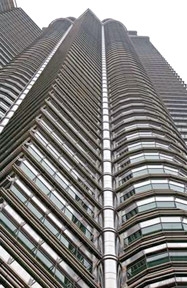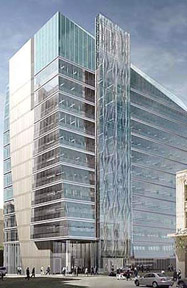
The design and placement of glass is a vital component of green architecture. It allows for natural light and integrates the interior of office and residential buildings with the exterior.
Natural light improves productivity in the workplace and helps maintain a healthy environment. Equally important is that glass materials and design promote energy efficiency.
Energy Efficiency
Architects rely on high-performance double-glazed glass, which is laminated or coated, to maintain interior temperatures by controlling heat loss and gain. The coating filters the heat-producing aspects of solar rays. The use of such glass in green buildings is used extensively in tropical climates and the Middle East. Glass resists water spots, damage from flying debris in bad weather and accumulation of dirt. The design and placement of glass, known as fenestration, in specific areas of the building creates the best environment for energy efficiency. In more mild climates, architects use operable windows as a cost-saving alternative to air-conditioning
Aesthetics

The 18-story One Westminster Place in London

San Francisco’s proposed 525 Gold Gate tower
Natural light is preferable to artificial light. Proper use of daylight is achieved through the design of the building’s façade, doors, skylights and windows. An emphasis is placed on integrating the exterior–natural sunlight, panoramic views and views of neighbouring buildings–with the interior to create a vibrant and unique environment. Extensive use of glass in post-World War II modern architecture creates skyscrapers that reflect sunlight to brighten city centers with crisp minimalist styling consisting of steel and glass. Using glass harmonises the building with its environment.
Cost Concerns
High-performance glass can be costly, prompting some builders to avoid specific designs as a cost-savings measure.
Builders and architects have struggled to implement high-performance glass for projects in such countries as the United Arab Emirates, where glass makes its greatest impact in an extremely hot environment. However, when high-performance glass is installed in offices, building maintenance costs drop significantly due to savings in energy costs and reduced building maintenance costs. In addition, exterior hydrophilic glass coatings reduce window cleaning. Architects also recognise that using high-performance glass in as many projects as possible creates a competitive market among suppliers that will ultimately lead to reduced costs.
Materials
Glass is recyclable, nontoxic and tough to break. When building glass does break, it is easy to replace. Contemporary office buildings employing green methods use low-emissivity, or “low-e,” glazing, which reduces the heat transfer from the exterior. The coating is used between double-glazed glass and consists of a semiconductor, which is a metal oxide virtually invisible to the eye.
Buildings
The 18-story One Westminster Place in London offers a glass façade consisting of layered glass walls that create an insulated buffer zone to extract energy from the captured hot air inside the zone.
San Francisco’s proposed 525 Gold Gate tower was expected in 2010 to feature large windows and light shelves, which are reflective overhangs placed above eye level, to bring natural light deep into the 255,000-square-foot building





